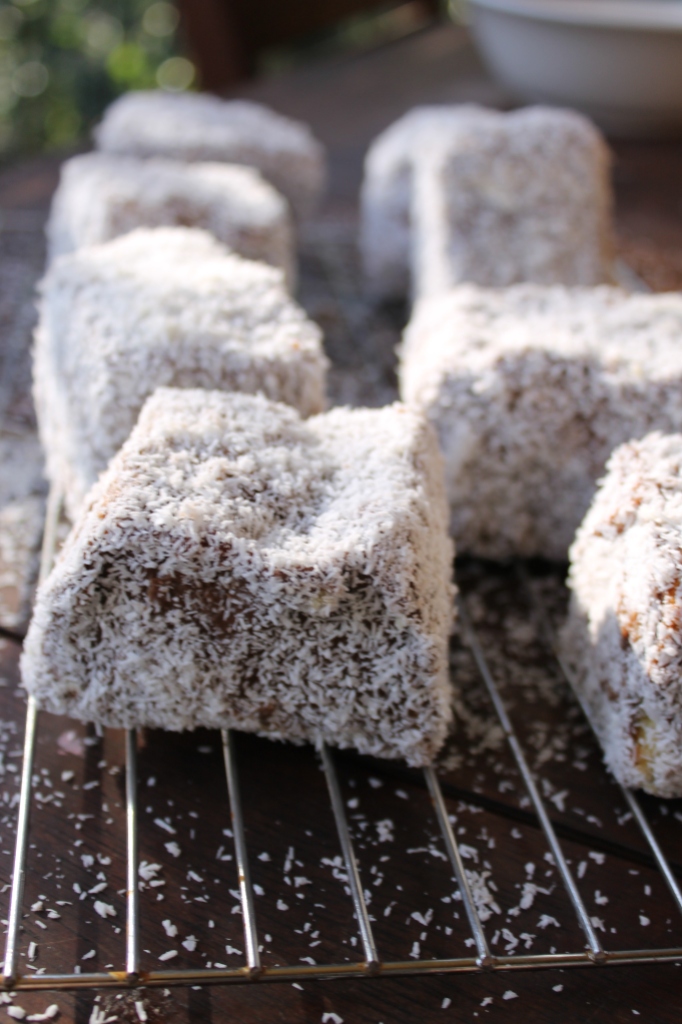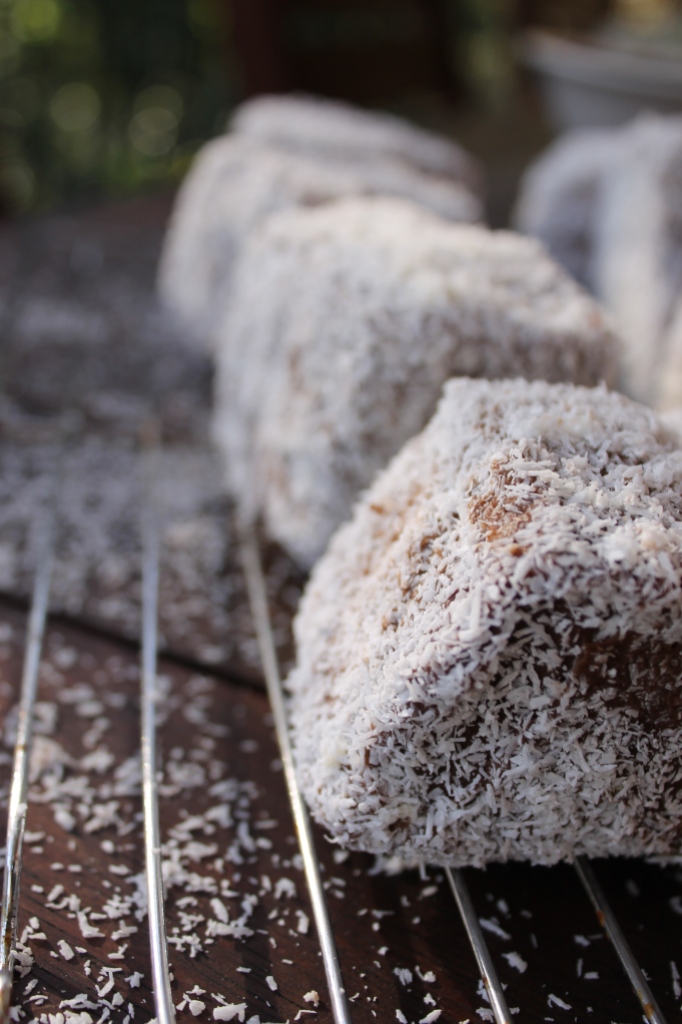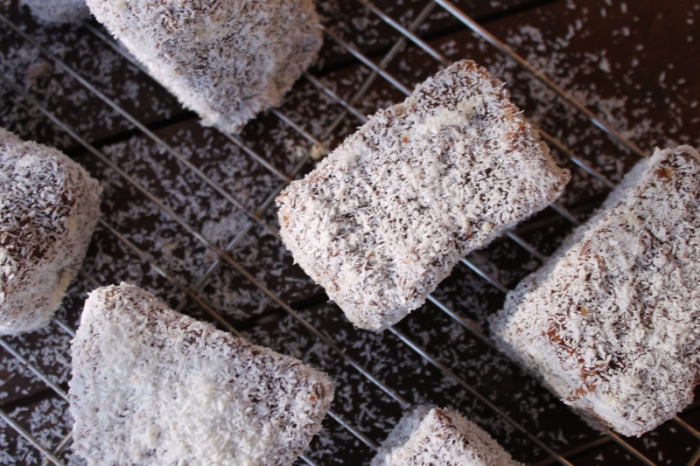When I’m travelling I love tasting the regional specialities and I try to make a point of asking the locals which foods represent their country or area, but when people ask me about Australian food I find it hard to know what to say. Sure, we have some iconic brands like Vegemite, Tim Tams or Milo and there is a range of native foods for the curious to try – lilly pilly, finger limes, kangaroo, emu, crocodile and witchetty grubs – but none of these really represents Australian cuisine.
In 2010 a discussion of the Australian national dish came up with “barbecue, meat pie, sausage sandwich, roast lamb, Vegemite on toast, pavlova, spag bol, lamingtons, chicken parmigiana … and ‘surf and turf’.”[1] Of these dishes, very few are Australian inventions (although the origins of some, like pavlova, are hotly debated). The exception is the lamington, which generally consists of two layers of plain sponge cake sandwiched together with jam and/or cream, rolled in a chocolate icing and desiccated coconut.
This rather unassuming cake has become an Australian favourite and is available in just about every bakery and meat pie shop in the country, but where did it come from? The stories about the invention of the lamington have entered our national myth and every schoolchild has heard that whilst preparing for an important dinner the cook accidentally dropped a sponge cake into a bowl of chocolate. Looking for a way to fix the situation he covered it in coconut and served it forth. Lord Lamington was duly impressed by the cake and when he asked what it was called, the cook replied that it would be named in his honour. The truth of the matter? This is only one of the many alternative stories which explain the lamington. The cakes could also have been named for Lady Lamington, which might make more sense if Lord Lamington really did refer to them as “bloody poofy woolly biscuits”, a statement that is widely quoted e.g. here, here and here, but never referenced.

Governor of Queensland, Lord Lamington, 1899. Image from the John Oxley Library, State Library of Queensland, Image no. 184102, public domain.
The Recipe
What we know for sure is that Lord Lamington served as the Governor of Queensland from 1896 to 1901 and that the first published lamington recipe dates from this period in Queensland. Taken from the Queensland Country Life in 1900 the recipe is as follows:
“Lamington Cakes – 1/2 cup of butter, 1 cup sugar, 1 cup flour, 3 eggs, 1 teaspoon baking powder, 4 tablespoons milk. Beat butter and sugar; add eggs well beaten with the milk, sift in flour and baking powder; flavour with vanilla or lemon to taste. Bake in sandwich tins, Cut in squares next day.
Icing- 3oz. icing sugar, 1oz. butter. Beat these to a cream and spread between the layers, as jam would be used. For the outside icing – 3oz. icing sugar, 1oz. butter, 3 teaspoons or more of cocoa; vanilla to flavour. The square of cake, when doubled, are in the shape of a cube. Ice all over the cube with the cocoa icing, spreading it with a knife, then dip and roll in desiccated coconut.”[2]
The main difference between this recipe and modern lamington recipes is the icing. In the recipe from 1900 the icing is a basic butter-cream, flavoured with cocoa, whilst modern recipes either dissolve the butter-cream with boiling water (e.g. this recipe) or omit the butter altogether (e.g. this recipe), giving a much wetter icing which is absorbed by the cake. In many ways I think that the modern method is preferable, it is both easier to apply to the cubes of cake and much less rich. I found that the icing from the original recipe overwhelmed the cake and was almost unpleasantly buttery. Nonetheless, I have provided the recipe below if you would like to try it in the original manner.
The Redaction
Lamington Cakes
For the cake:
1/2 cup butter
1 cup sugar
1 cup plain flour
3 eggs
1 tsp baking powder
4 tbsp milk
Vanilla essence or grated lemon peel to taste
For the filling:
85g icing sugar, sifted
30g butter, softened
For the icing:
85g icing sugar, sifted
30g butter, softened
3 tsp cocoa powder
1/2 tsp vanilla essence
Desiccated coconut
- Preheat the oven to 180˚C. Grease and line two sandwich tins, running the baking paper across the bottom and up both long sides of the tin and leaving a 2cm overhang on each side.
- Beat the butter and sugar for the cake until light and creamy. Whisk together the eggs and milk and gradually mix them into the butter mixture. Sift in the flour and baking powder and gently fold them in before adding the vanilla or lemon.
- Divide the batter between the two tins and bake for 20 mins or until risen and golden brown. Leave to cool slightly then, using the overhanging paper, lift the slabs of cake onto wire racks to cool. When cool, cover the cakes and leave overnight.
- The next morning cut the cakes into squares 3-4cm long. Beat together the ingredients for the filling until light and creamy. Use the filling to join two squares of cake, one on top of the other, to make cubes.
- Beat together the icing ingredients, except the coconut. Place the coconut into a bowl. Spread the icing all over the cubes of cake then roll the cube in the coconut to cover each side. Serve for morning or afternoon tea.
The Recipe: Lamington Cakes from Queensland Country Life (available here)
The Date: 1900
How did you make it?: See above.
Time to complete?: About two and a half hours, plus cooling time, spread over two days.
Total cost: I already has all the ingredients.
How successful was it?: I found them just too buttery and creamy, and the ones I made were quite large but you could only eat half a cake at a time because they were so rich.
How accurate?: Pretty good I think, the ingredients and methods haven’t changed very much so it’s quite easy to recreate.
[1] Barbara Santich, Bold Palates: Australia’s Gastronomic Heritage (South Australia: Wakefield Press, 2012), 25.
[2] “Useful Recipes.,” Queensland Country Life, December 17, 1900.
Bibliography
Santich, Barbara. Bold Palates: Australia’s Gastronomic Heritage. South Australia: Wakefield Press, 2012.
“Useful Recipes.” Queensland Country Life. December 17, 1900.


